Critical Examination Of the ‘Confusion’ Term
Before registering a trademark, we first must understand what can be registered as a trademark. Further, what are the possible grounds for refusing the registration?
This article will explore a common ground of trademark registration refusal: “Confusion.” The term confusion has two meanings within the Trademarks Act 1999, connoting different things under Section 9 and Section 11 of the Act 1999. This article will examine the difference between the two sections.
According to Section 9 (2)(a), a trademark cannot be registered if it is of such nature as to deceive the public or cause confusion. This means that the confusion is caused due to an inherent quality present in the Trademark.
According to Section 11(1), a trademark cannot be registered if it is deceptively similar to an earlier trademark. So, in this case, the likelihood of confusion is caused due to the similarity between the two marks.
To better understand this, let us look at Sections 9 and 11 in detail:
SECTION 9 OF THE TRADEMARKS ACT, 1999
Section 9 details the absolute grounds of refusal for registration of a trademark.
Further, section 9 (2) (a) of the Trademarks Act, 1999 states:
“A mark shall not be registered as a trademark if—
(a) it is of such nature as to deceive the public or cause confusion;
Section 9 (2) (a) talks about the deceptive nature of the mark. It means that the mark by itself is not fit for registration. That means the mark may suggest one thing but end up being another.
For instance, ‘Pure Ghee’ is used for the Vanaspati product. The latter is made of hydrogenated vegetable fat, which has harmful effects on the human body, as opposed to ghee which has proven health benefits for humans. So the use of the term Pure Ghee would be considered deceptive as it is suggestive of something it is not.
Therefore, any trademark with any misleading information that is likely to cause deception or confusion in the minds of the public will not be registered.
Let us look at a hypothetical scenario. Suppose a person sells his leather products by marking them as a ‘tanned leather product.’ But in reality, he sells untanned leather products. Then, we may say that using the term ‘tanned leather product’ is likely to cause confusion in the public’s minds.
The whole purpose of Section 9(2)(a) is to protect the public from being deceived concerning the nature, function, quality, or purpose of a product or service.
SECTION 11 OF THE TRADEMARKS ACT, 1999.
Section 11 of the Trademarks Act, 1999 states the relative grounds of refusal, and Section 11 (1) (b) states:
“11. Relative grounds for refusal of registration.—
(b) its similarity to an earlier trademark and the identity or similarity of the goods or services covered by the Trademark, there exists a likelihood of confusion on the part of the public, which includes the likelihood of association with the earlier Trademark.”
Simply put, Section 11 states that a trademark cannot be registered if it is deceptively similar to an earlier existing trademark. This Section also says that if an earlier trademark is well–known in India, a similar mark may not be registered.
Under Section 11 (1) of the Trademarks Act, 1999, confusion may arise in the minds of the consumers due to any of the following reasons –
1. Related Goods or Services
2. Similarity in Sound
3. Similarity in Appearance of Text
4. Similarity in Meaning
5. Similarity in Design Marks
This Section pertains to comparing the two or more marks in question and determining in their totality whether the two marks may cause confusion in the users’ minds. For example, Starbucks & Sordorbaksh coffee.
When the two marks in question are compared, all the aspects of the mark, such as visual, phonetic, and structural, must be considered.
Section 11 helps the public not create confusion between two brands and helps the trademark owner by not letting any other person free ride on the goodwill the owner has built.
Example
For example, “Black Magic” for laxative goods and “Black Magic” for chocolate that contains a laxative may lead to confusion.
Therefore, a particular mark has to be compared with another trademark to determine the cause of confusion. When examining the deceptive similarity, it is essential to consider each mark’s goods and/or services.
For example, ‘PUMA’ and ‘COMA’ for sports apparel, sports goods, etc., will be termed ‘deceptively similar.’ However, if ‘COMA’ is registered under any other class, such as restaurant services, it may not be considered deceptively similar.
The doctrine of ‘deceptive similarity’ or ‘likelihood to confusion’ must not be construed strictly. But it should depend on the facts and circumstances of each case. The burden of proof lies on the Applicant to prove that there is no deceptive similarity that shall cause confusion.
Conclusion
There is a stark difference between the ‘confusion’ that is addressed under Section 9 (2) (a) and Section 11 (1). The former relates to whether the mark by itself is deceptive or trying to mislead the public. Whereas Section 11(1) arises when comparing two or more marks and determining a likelihood of confusion between the two marks. They are integral sections meant to protect the public from being deceived, whether about the quality of a product/service or its source.
[cherry_button text=”Need Help? Reach Us” url=”https://www.intepat.com/contact-us/” style=”warning” centered=”yes” fluid_position=”right” icon_position=”top” bg_color=”#f79351″ min_width=”33″ target=”_blank”]





